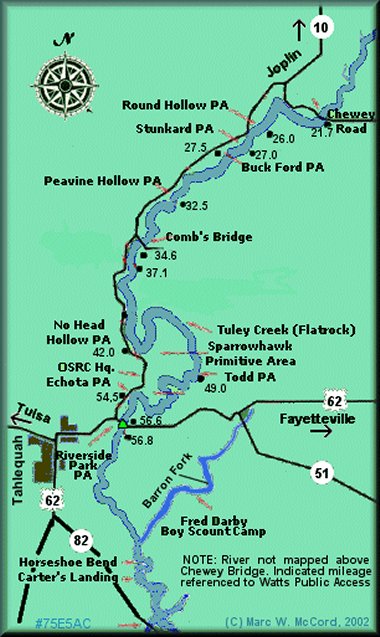The Illinois River is a very scenic river with no rapids, and its only hazards are occasional downed trees across parts of the river channel. The river is, however, wide enough in
most places to avoid those trees by paddling around them. The river is popular during summer months, but generally much less crowded during
the late spring, so we will not be paddling among huge groups of people, and we are likely to have few others sharing
the campground with us. The Illinois is a popular fishing river, so bring your tackle if you have an Oklahoma fishing license - game wardens DO check licenses on this river!
Most of us will drive to Tahlequah on Friday afternoon or evening and camp overnight at Sparrow Hawk Camp on SH 10. Depending upon flow, we will paddle various reaches of the river on Saturday and Sunday before returning home. Camping fees are $12 per car per night for up to three tents, so ride sharing is encouraged to save money. There is an Oklahoma Scenic Rivers Commission (OSRC) launch fee of $1.00 per person per day, and a separate wrist band is required for each day. These are available at Sparrow Hawk Camp, as well as from the OSRC headquarters on SH 10 near Sparrow Hawk Mountain.
We plan to have a potluck dinner on Saturday night, but the cuisine has not yet been determined. Bryan will send out an e-mail blast giving you instructions on the cuisine so that you can bring something to share that will be compatible with the entree'.
For more information contact Bryan Jackson at (972) 972-2519. You can also contact Bryan via email to Bryan Jackson.
Please contact Bryan Jackson if you are thinking of coming so he can expect you and notify you of any changes.
Gear Requirements:
Almost any river worthy boat will suffice for this flat water trip. Bring PFD's, a whistle and
throw bag for each person. October should be mild, but could be cool at night. Bring sun protection - a hat and sun block - and light rain gear just in case. Also bring everything you may want for camping - tent, sleeping bag, chair, etc. Water is supplied at the park.
Meals:
Bring all your own meals, utensils, plate, cup, etc. We will have lunch on the river Saturday, so bring a small cooler or bag for it, but PLEASE - NO GLASS OR FOAM POLYSTYRENE STYROFOAM CONTAINERS! We will have a potluck on Saturday night (cuisine TBD.)
Back-up Plans:
There is currently no backup plan for this trip. If, for any reason, the trip on the Illinois River cannot be made, then we will explore other options in SE Oklahoma.
Driving Directions:
This reach of the Illinois River is located in Cherokee County on SH 10 just northeast of Tahlequah.
From Dallas:


